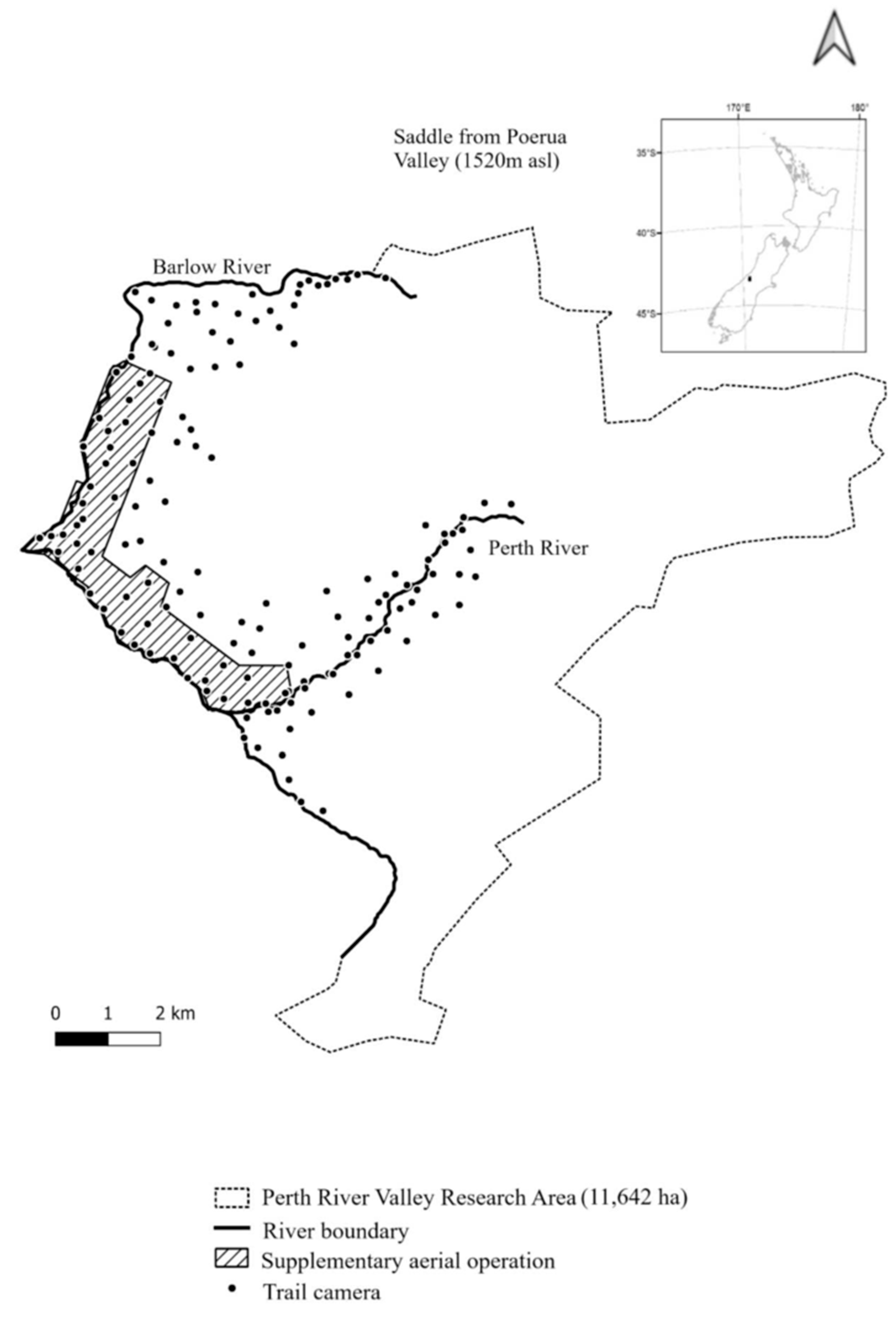Reply to Barron et al. Comment on “Cook, B.; Mulgan, N. Targeted Mop up and Robust Response Tools Can Achieve and Maintain Possum Freedom on the Mainland. Animals 2022, 12, 921”
1. Introduction
2. Response
2.1. Spatial Extent
2.2. Area Monitored

2.3. Detections
2.4. Detectability Calculation
2.5. Detectability Comparison with the Literature
2.6. Model
2.7. Assumptions
3. Results
4. Conclusions
Conflicts of Interest
References
- Cook, B.; Mulgan, N. Targeted Mop up and Robust Response Tools Can Achieve and Maintain Possum Freedom on the Mainland. Animals 2022, 12, 921. [Google Scholar] [CrossRef] [PubMed]
- Barron, M.; Anderson, D.P.; Norbury, G.; Warburton, B. Comment on Cook, B.; Mulgan, N. Targeted Mop up and Robust Response Tools Can Achieve and Maintain Possum Freedom on the Mainland. Animals 2022, 12, 921. Animals 2023, 13, 1840. [Google Scholar] [CrossRef]
- Landcare Research New Zealand Ltd. LCDB v5.0—Land Cover Database version 5.0, Mainland, New Zealand. 2020. Available online: https://lris.scinfo.org.nz/layer/104400-lcdb-v50-land-cover-database-version-50-mainland-new-zealand/ (accessed on 15 October 2023).
- Cowan, P.E.; Glen, A.S. Trichosurus vulpecula. In The Handbook of New Zealand Mammals, 3rd ed.; King, C.M., Forsyth, D.M., Eds.; Family Phalangeridae; CSIRO Publishing: Melbourne, Australia, 2021; pp. 43–77. [Google Scholar]
- Margetts, B.I.; Ross, J.G.; Buckley, H.L. Measuring Home-Range Changes Following Density Reduction of Australian Brushtail Possum. J. Wildl. Manag. 2020, 84, 185–192. [Google Scholar] [CrossRef]
- Cowan, P.E. Denning habits of common brushtail possums, Trichosurus vulpecula, in New Zealand lowland forest. Aust. Wildl. Res. 1989, 16, 63–78. [Google Scholar] [CrossRef]
- Hickling, G.J.; Forsyth, D.M. Assessment of the extent of alpine areas being utilised as possum habitat in Westland. In Lincoln University Wildlife Management Report; Lincoln University: Lincoln, New Zealand, 2000; p. 21. Available online: https://researcharchive.lincoln.ac.nz/server/api/core/bitstreams/01d72861-2c7f-47b5-a989-453b3d3d309e/content (accessed on 15 October 2023).
- Ball, S.J.; Ramsey, D.; Nugent, G.; Warburton, B.; Efford, M. A method for estimating wildlife detection probabilities in relation to home-range use: Insights from a field study on the common brushtail possum (Trichosurus vulpecula). Wildl. Res. 2005, 32, 217–227. [Google Scholar] [CrossRef]
- Borchers, D.L.; Efford, M.G. Spatially explicit maximum likelihood methods for capture–recapture studies. Biometrics 2008, 64, 377–385. [Google Scholar] [CrossRef] [PubMed]
- Efford, M.G.; Boulanger, J. Fast evaluation of study designs for spatially explicit capture–recapture. Methods Ecol. Evol. 2019, 10, 1529–1535. [Google Scholar] [CrossRef]
- Samaniego-Herrera, A.; Anderson, D.P.; Parkes, J.P.; Aguirre-Muñoz, A. Rapid assessment of rat eradication after aerial baiting. J. Appl. Ecol. 2013, 50, 1415–1421. [Google Scholar] [CrossRef]
- Whyte, B.I.; Ross, J.G.; Blackie, H.M. Differences in brushtail possum home-range characteristics among sites of varying habitat and population density. Wildl. Res. 2013, 40, 537–544. [Google Scholar] [CrossRef]
- Sweetapple, P.; Nugent, G. Possum demographics and distribution after reduction to near–zero density. New Zealand J. Zool. 2009, 36, 461–471. [Google Scholar] [CrossRef]

| 2019 | 2020 | 2021 | |
|---|---|---|---|
| Distinct camera-days detecting | 26 | 31 | 21 |
| Distinct Cameras detecting | 13 | 13 | 8 |
| Captures | 0 | 7 | 2 |
| 2019 | 2020 | 2021 | |
|---|---|---|---|
| Estimated possums | 15 | 12 | 10 |
| 2.5 percentile | 10 | 8 | 7 |
| 97.5 percentile | 28 | 22 | 18 |
Disclaimer/Publisher’s Note: The statements, opinions and data contained in all publications are solely those of the individual author(s) and contributor(s) and not of MDPI and/or the editor(s). MDPI and/or the editor(s) disclaim responsibility for any injury to people or property resulting from any ideas, methods, instructions or products referred to in the content. |
© 2023 by the authors. Licensee MDPI, Basel, Switzerland. This article is an open access article distributed under the terms and conditions of the Creative Commons Attribution (CC BY) license (https://creativecommons.org/licenses/by/4.0/).
Share and Cite
Cook, B.; Mulgan, N. Reply to Barron et al. Comment on “Cook, B.; Mulgan, N. Targeted Mop up and Robust Response Tools Can Achieve and Maintain Possum Freedom on the Mainland. Animals 2022, 12, 921”. Animals 2023, 13, 3343. https://doi.org/10.3390/ani13213343
Cook B, Mulgan N. Reply to Barron et al. Comment on “Cook, B.; Mulgan, N. Targeted Mop up and Robust Response Tools Can Achieve and Maintain Possum Freedom on the Mainland. Animals 2022, 12, 921”. Animals. 2023; 13(21):3343. https://doi.org/10.3390/ani13213343
Chicago/Turabian StyleCook, Briar, and Nick Mulgan. 2023. "Reply to Barron et al. Comment on “Cook, B.; Mulgan, N. Targeted Mop up and Robust Response Tools Can Achieve and Maintain Possum Freedom on the Mainland. Animals 2022, 12, 921”" Animals 13, no. 21: 3343. https://doi.org/10.3390/ani13213343





